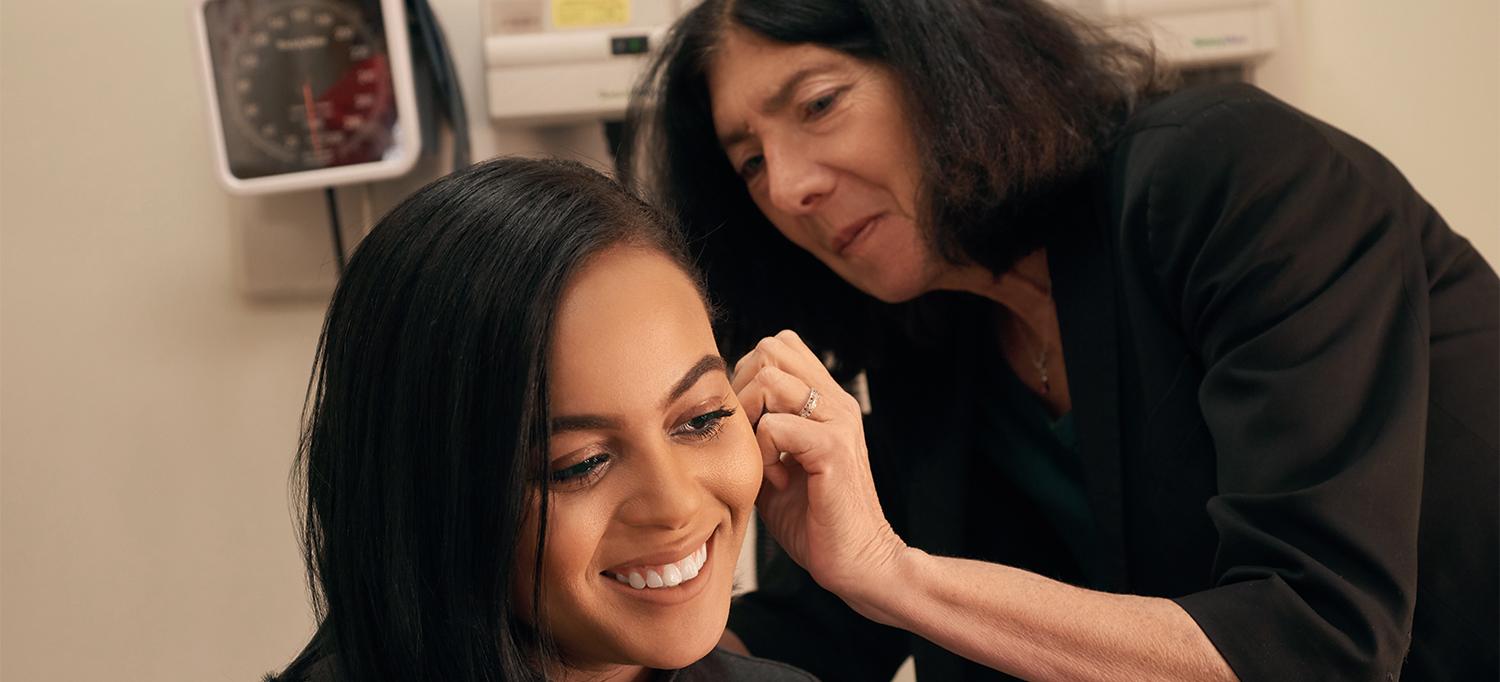NYU Langone Health Researchers Are Leading Efforts to Help Identify & Treat Those Who Are Most Susceptible to This Debilitating Autoimmune Disease

At NYU Langone's Lupus Center in Manhattan, Dr. Jill Buyon examines her patient Sabina Batista during a follow-up visit.
Photo: Sasha Nialla
For years, Sabina Batista had symptoms doctors could not explain: periodic swelling in her left leg, lower back pain, and a strange tingling sensation in her fingers and toes. The 28-year-old social services case manager from Yonkers, New York, recalls that physicians routinely dismissed or misdiagnosed her health complaints until 2016, when she was finally diagnosed with lupus. The incurable and potentially life-threatening autoimmune disease triggers bouts of inflammation and attacks the body’s tissues and organs. In Batista’s case, it had begun to assail her kidneys.
For mysterious reasons, lupus hits some people harder than others. Of the estimated 1.5 million Americans afflicted by the disease, most are women of childbearing age. Studies have shown that black women are about three times more likely to suffer from lupus than white women. Now, research published recently by rheumatologists at NYU Langone Health suggests that lupus also takes a heavy toll on Asian and Hispanic women. “They’re two of the fastest-growing populations, but data regarding their risk for lupus has been limited,” says rheumatologist Peter M. Izmirly, MD, the study’s lead author.
Rheumatologists at NYU Langone Health have found that lupus is not only more prevalent among women of color, but also much more aggressive.
The epidemiological sleuthing by Dr. Izmirly’s research group, called the Manhattan Lupus Surveillance Program, and a related effort called the California Lupus Surveillance Project, documented similar racial and ethnic disparities among men, although at much lower rates. The reasons for these differences are unknown, though data suggest that both genetic and environmental factors play a role.
After her diagnosis, Batista, who is of Dominican heritage, tried to learn all she could about the disease. Her desire for a second opinion led her to NYU Langone, where specialists have long treated a racially and ethnically diverse mix of patients from the New York metropolitan area. That experience is critical, given that Dr. Izmirly’s latest findings suggest the disease is not only more prevalent among women of color, but also much more aggressive. “About half the patients with lupus who are black, Asian, or Hispanic are, based on our data, likely to develop lupus kidney disease, compared to only about a quarter of those in the white population,” says Dr. Izmirly.
Lupus is devilishly difficult to diagnose. Symptoms can be vague, and there’s no definitive diagnostic test. The disease is often associated with a butterfly-shaped rash that covers the bridge of the nose and both cheeks, but not all patients develop this telltale sign. Batista, for example, didn’t develop the rash until after multiple tests and referrals finally led to a diagnosis.
Dr. Izmirly says healthcare providers should be on the lookout when assessing a range of signs and symptoms—including rashes, joint pain, and signs of kidney disease, such as abnormal urinalysis results, swelling in the legs, and unexplained high blood pressure. “By the time we see some of these patients, they’ve already had irreversible damage,” he says. “So the earlier the diagnosis, the more likely we are to get on top of it and hopefully improve outcomes.”
Under NYU Langone’s care, Batista found that her disease was far more manageable with the right interventions. An initial daily dose of nine medications had left her depressed, in pain, and unable to sleep.
Under the care of doctors at NYU Langone, Sabina Batista found that her disease was far more manageable with the right interventions.
Her new rheumatologists, Dr. Izmirly and Jill P. Buyon, MD, co-directors of the Lupus Center at NYU Langone, cut that drug regimen by more than half. Along with medication to suppress her lupus-associated kidney disease, Batista now takes an antimalarial drug to suppress flare-ups and an anticoagulant to prevent blood clots, a risk for some patients. Dr. Buyon, the Lady Va and Sir Deryck Maughan Professor of Rheumatology, also encouraged Batista to adopt a healthier diet and lifestyle to help manage her symptoms. “I feel a lot better,” Batista says. “I haven’t had a flare-up in months.”
At the scientific level, Dr. Buyon, Dr. Izmirly, and their research collaborators are exploring potential genetic and environmental links to explain why some groups are more likely to develop lupus and fare worse than others. “The outcome over time is probably some combination of socioeconomic and behavioral, in addition to racial and ethnic, factors,” says Dr. Izmirly.
More answers may come from NYU Langone’s Translational Center of Molecular Profiling in Preclinical and Established Lupus, or COMPEL. A new 5-year, $6.7 million grant from the National Institutes of Health will aid the researchers’ efforts to better characterize lupus in a racially and ethnically diverse group of patients. “It’s about looking at women who are at high risk and understanding why they do or don’t develop the disease,” Dr. Buyon says, “and then looking at people with established lupus and understanding what makes the disease flare.”

